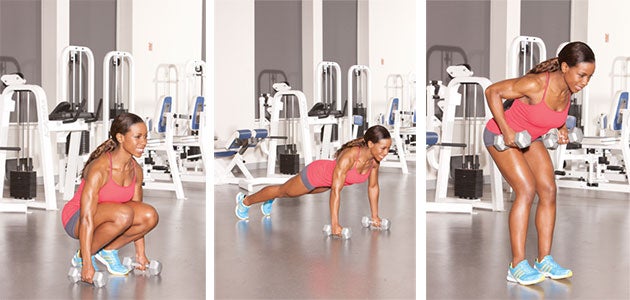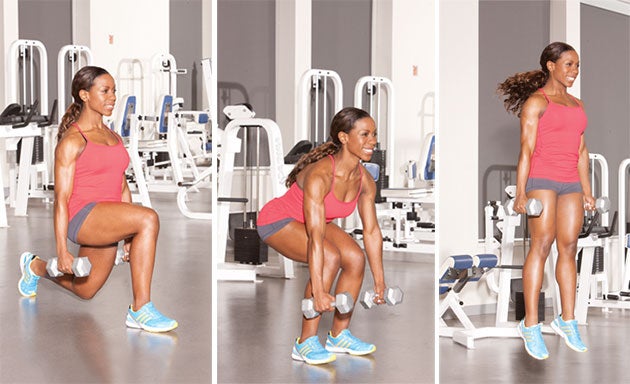Heading out the door? Read this article on the new Outside+ app available now on iOS devices for members! Download the app.
Want to know a secret? Your body isn’t an effective multitasker. For your fitness goals, that means it’s not very good at simultaneously burning fat and building muscle. This is basically the metabolic equivalent of patting your head while rubbing your tummy: it is possible, but can be clumsy.
The formula for dealing with this has always been to split up your efforts with weight training to build muscle and a separate cardio-only session to provide the burn. While this may get the job done, there is a better way to accomplish both goals at once: with metabolic chains.
What Is a Metabolic Chain?
Metabolic chains are two or more weight-based exercises strung together that fully activate your heart and lungs. They use strength exercises to create a cardio-free fat burn with an aftershock that keeps your metabolism revved long after your workout is over.
The idea behind this method is to combine the high-octane calorie burn achieved through cardio intervals with the muscle-defining benefits of superset weight training. The result: you burn fat and build muscle thanks to a short, results-driven workout — no cardio machines required.
How Do They Work?
You may already use supersets in your workouts. Metabolic chains are similar, but with an exciting twist. While superset exercises are distinct and separate, metabolic chains link exercises into a seamless movement: a squat may be followed by a biceps curl, then a shoulder press, creating a “chain” of exercises. The three moves combined make for one rep of the chain.
As you continue performing your chains, you will achieve a tremendous calorie burn similar to that of cardiovascular interval training. This high-intensity effort maximizes calories burned not only during exercise, but after your workout as well. Want proof? Studies have shown that women engaging in a fast-paced superset workout can elevate their fat-burning metabolism by about 60 percent for 16 hours after exercise. And another study published in the International Journal of Obesity found that 15 weeks of this type of exercise burned over twice as much fat when compared to more traditional aerobic exercise.
Muscle Shaping
This chain set-up of exercises provides the cardio burn, but what about muscle building? Muscle growth requires an overload stimulus, so one exercise in the chain is chosen as the focus. With each successive repetition of the chain, the reps for the “focus movement” are increased by one (see “Constructing A Metabolic Chain”). This addition of reps causes a fat-burning and muscle-building synergy that the body simply cannot ignore.
Research supports the dual fat-burning and muscle-defining capabilities of this type of training. In 2008, researchers from the University of California at Santa Cruz found that in comparison to a traditional “weights first, cardio second” workout, a combination of weightlifting with short, high-intensity bursts of cardiovascular activity boosted subjects’ fat burning by almost 10 times, while also delivering about 85 percent greater muscle development.
Your bonus: the power of this weight-based cardio workout generates a large caloric burn during exercise and keeps you dropping ample fat calories well after you are through. A 130-pound female, for example, can quickly smoke 300 to 350 calories during a 30-minute metabolic chain workout, with another 300 to 500 calories being easily used up over the next 24 hours as the body rests and recovers.
Three Chains to Torch Fat and Build Strength
With a metabolic chain workout, there is no “traditional cardio,” no stop-and-go circuits and no conventional sets-and-reps format. This is a complete paradigm shift for developing lean muscle mass while stripping off excess fat.
Try these three metabolic chains, doing each one for up to 10 minutes with little rest in between, for an integrated workout that saves you time and delivers results. Short on time? Do each one for five minutes, or do a single chain for 10 minutes.
Chain 1: Burpee & Row Chain
• The Base: A burpee provides a full-body metabolic stimulus.
• The Chain: A bent-over row at the top makes for a highly effective chain.
• The Focus: Add one row when you repeat the chain. When you get to 10, start over at one.
• Time it: Go for five to 10 minutes. Rest whenever you need it, and start up again right where you left off.
Burpee to Bent-Over Row

Target Muscles: quadriceps, glutes, latissimus dorsi, trapezius, rhomboids
Set Up: Stand with your feet hip-width apart, arms at your sides with a dumbbell in each hand.
Action: Squat, placing your hands on the floor by your feet. Jump your feet behind you, then jump them forward and stand. Next, bend your knees slightly and lean forward from your hips. Row the weights up, then extend your arms and return to the start. Repeat until your time is through, adding another row with each chain until you reach 10, then start again from one.
Training Tip: If the dumbbells roll around as you perform the burpee, use hexagon-shaped weights (as shown), or forgo them altogether; simply pick them up from the ground when you need to do the row.
Training Tip: Beginners can step their feet back one at a time instead of jumping both feet behind them.
Chain 2: The Incline Curl & Press Chain
• The Base: Going from a seated incline position on a bench to a standing position works the legs and core, and will get the lungs going.
• The Chain: Do a dumbbell curl while seated on the bench, and an overhead shoulder press when you are in the standing position.
• Time it: Go for five to 10 minutes. Do as many chains as possible with proper form; if you need to, rest until you’re ready to start again, and always resume the chain where you left off.
Incline Biceps Curl to Shoulder Press

Target Muscles: biceps brachii, quadriceps, gluteus maximus, deltoids
Set Up: Sit on an incline bench set to a 45- or 60-degree angle. Hold a dumbbell in each hand, palms facing forward and arms directed toward the floor.
Action: Bend your elbows while keeping your upper arms still to raise the dumbbells toward your shoulders. Lower the weights, then immediately stand. Raise your arms so your hands point toward the ceiling, with elbows bent as shown], then press the weights above your head. Repeat the chain for the specified amount of time, adding one overhead shoulder press every time you repeat the sequence.
Training Tip: As you set up your bench, make sure your feet are flat on the floor at the beginning, so that you can press through your heels to stand.
Chain 3: The Lunge, Squat & Jump Chain
• The Base: A jump squat with dumbbells is highly metabolic.
• The Chain: Start with a lunge, then add a squat as a precursor to the jump for an intense leg-burning chain.
• The Focus: In this case, the base exercise is also the focus. Tack on another jump every time you repeat the sequence, until you get to 10 jumps. Then start over at one and do it again.
• Time it: Push hard for five to 10 minutes, but rest as you need to. Get back into the workout when you’re ready, starting from where you ended.
Lunge, Squat to Jump Squat

Target Muscles: quadriceps, gluteus maximus
Set Up: Stand with your feet hip-width apart, holding a light to medium weight in each hand at your sides.
Action: Step your right foot forward and lunge. Return to the start, then immediately bend your knees and lower your hips to perform a squat; stop when your thighs are almost parallel to the ground. Press through your heels to stand, then squat once again, this time exploding into the air as you rise . Tack on a jump squat with every repetition of the chain, working your way up to 10, then start again with one rep and continue for the remainder of your time. Alternate your front leg with each lunge.
Ride the Metabolic Wave
The latest science reveals it’s not just what happens during your workout that matters, but also what happens after. Standard weight training followed by cardio does burn calories during exercise, but when the workout ends, so does the burn. There are four tools to make the burn last long after you finish your routine, and this workout targets them all. They are the Bs and Hs: breathless, burning, heavy and heat:
• Breathless. Gasping for breath after your chains? Pushing until you’re breathless triggers adrenaline, a factor in igniting your workout after-burn.
• Burning. Research out of the British Journal of Sports Medicine shows that lactic acid is a signal for the release of human growth hormone, which triggers simultaneous fat loss and muscle growth. With metabolic chains, the volume of reps delivers a strong stimulus to harness the power of lactic acid.
• Heavy. Using type II muscle fibers triggers testosterone production, another fat-burning, muscle-building hormone. Type II (or fast-twitch) fibers are activated with quick weighted movements like the ones in your chains.
• Heat. Sweating can be a response to adrenaline, which helps release fat stores. Check your towel — your postworkout sweat is proof that your fat-burning engines are revving.
Constructing a Metabolic Chain
You are five steps away from making your own chain. Here’s what you should be looking for:
Get metabolic: Choose a base exercise to activate fat burning. Burpees and jump squats are great places to start.
Build the chain: From the base exercise, “chain together” two to four movements. For example, adding a push-up at the bottom of a burpee and an overhead press at the top creates a challenging chain.
Get focused: Isolate a body part by adding reps to one of the exercises. Want to target your chest? Do one push-up the first time you repeat the chain, and continue adding one rep each time you repeat it. When you reach 10 reps, start over at one and do it again.
Choose your weights: Pick a dumbbell with which you can knock out 10 reps of the toughest movement. If you’re a pro at curls but need to work on your overhead presses, you should be able to eke out 10 shoulder presses with your chosen weight.
Time it: Set your stopwatch for five to 10 minutes. Rest when you need to, and begin again right where you left off.